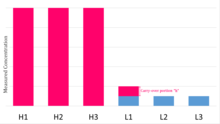252:
concern is a potential for carryover of analyte from one patient specimen into one or more following patient specimens, which can falsely increase or decrease the measured analyte concentration. Specimen carryover is typically addressed by judicious choice of probe material, probe design, and an efficient probe washing system to flush the probe of residual patient specimens or reagents retained in their bores or clinging to the probe exterior surface before they are introduced into the next patient sample, reagent container, or cuvette/reaction vessel.
165:
63:
22:
269:
276:
IUPAC made a recommendation in 1991 for the description and measurement of carryover effects in clinical chemistry. The carryover ratio is the percentage of H3 carry to L1 constituting the carryover portion "h". In a design of 3 high samples followed by 3 low samples, h can be calculated as (L1 -
251:
Carryover experiments are widely used for clinical chemistry and immunochemistry analyzers to evaluate and validate carryover effects. The pipetting and washing systems in an automated analyzer are designed to continuously cycle between the aspiration of patient specimens and cleaning. An obvious
242:
is a term used in clinical chemistry to describe the transfer of unwanted material from one container or mixture to another. It describes the influence of one sample upon the following one. It may be from a specimen, or a reagent, or even the washing medium. The significance of carry over is that
280:
The carryover ratio's acceptance criteria depend on the measurement and the laboratory concerned. For example, 1% carryover of plasma albumin would generally lead to a clinically insignificant effect, while 1% carryover of cardiac High sensitivity
Troponin assay would be catastrophic.
260:
The pathological range of measurement could be of several order to reference interval(e.g., Sex hormone, Tumor marker, Troponin...etc.). A small portion of carryover could lead to erroneous results.
175:
127:
99:
188:
106:
225:
207:
146:
80:
49:
35:
300:"Proposals for the description and measurement of carry-over effects in clinical chemistry (Recommendations 1991)"
113:
84:
95:
73:
120:
41:
183:
8:
353:
329:
321:
333:
311:
347:
325:
316:
299:
272:
Carryover illustration in a typical carryover study in automated analyzer
62:
268:
246:
255:
243:
even a small amount can lead to erroneous results.
87:. Unsourced material may be challenged and removed.
345:
277:mean of L2&L3) / (H3 - mean of L2&L3)
192:that contextualizes different points of view.
178:to certain ideas, incidents, or controversies
50:Learn how and when to remove these messages
315:
226:Learn how and when to remove this message
208:Learn how and when to remove this message
147:Learn how and when to remove this message
267:
297:
263:
247:Carryover effect in clinical laboratory
346:
256:Significance in carryover assessment
158:
85:adding citations to reliable sources
56:
15:
13:
14:
365:
31:This article has multiple issues.
163:
61:
20:
72:needs additional citations for
39:or discuss these issues on the
291:
1:
284:
7:
10:
370:
304:Pure and Applied Chemistry
298:Haeckel, R. (1991-01-01).
317:10.1351/pac199163020301
273:
271:
186:by rewriting it in a
264:Carryover assessment
81:improve this article
274:
96:"Carryover effect"
236:
235:
228:
218:
217:
210:
172:This article may
157:
156:
149:
131:
54:
361:
338:
337:
319:
295:
240:carryover effect
231:
224:
213:
206:
202:
199:
193:
189:balanced fashion
167:
166:
159:
152:
145:
141:
138:
132:
130:
89:
65:
57:
46:
24:
23:
16:
369:
368:
364:
363:
362:
360:
359:
358:
344:
343:
342:
341:
296:
292:
287:
266:
258:
249:
232:
221:
220:
219:
214:
203:
197:
194:
184:help improve it
181:
168:
164:
153:
142:
136:
133:
90:
88:
78:
66:
25:
21:
12:
11:
5:
367:
357:
356:
340:
339:
310:(2): 301–306.
289:
288:
286:
283:
265:
262:
257:
254:
248:
245:
234:
233:
216:
215:
171:
169:
162:
155:
154:
69:
67:
60:
55:
29:
28:
26:
19:
9:
6:
4:
3:
2:
366:
355:
352:
351:
349:
335:
331:
327:
323:
318:
313:
309:
305:
301:
294:
290:
282:
278:
270:
261:
253:
244:
241:
230:
227:
212:
209:
201:
191:
190:
185:
179:
177:
170:
161:
160:
151:
148:
140:
129:
126:
122:
119:
115:
112:
108:
105:
101:
98: –
97:
93:
92:Find sources:
86:
82:
76:
75:
70:This article
68:
64:
59:
58:
53:
51:
44:
43:
38:
37:
32:
27:
18:
17:
307:
303:
293:
279:
275:
259:
250:
239:
237:
222:
204:
195:
187:
176:undue weight
173:
143:
134:
124:
117:
110:
103:
91:
79:Please help
74:verification
71:
47:
40:
34:
33:Please help
30:
285:References
198:April 2022
137:April 2022
107:newspapers
36:improve it
354:Chemistry
326:0033-4545
42:talk page
348:Category
334:32706201
182:Please
121:scholar
332:
324:
123:
116:
109:
102:
94:
330:S2CID
174:lend
128:JSTOR
114:books
322:ISSN
238:The
100:news
312:doi
83:by
350::
328:.
320:.
308:63
306:.
302:.
45:.
336:.
314::
229:)
223:(
211:)
205:(
200:)
196:(
180:.
150:)
144:(
139:)
135:(
125:·
118:·
111:·
104:·
77:.
52:)
48:(
Text is available under the Creative Commons Attribution-ShareAlike License. Additional terms may apply.
